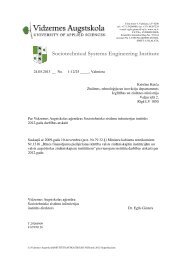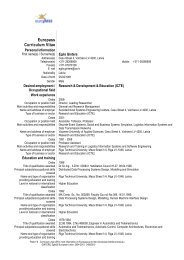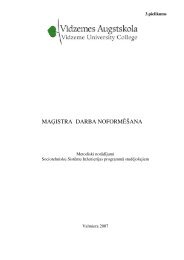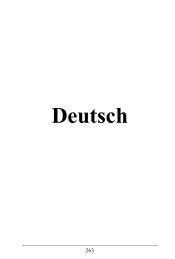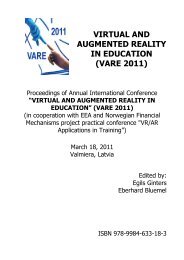A GLOBAL SIMULATION MODEL OF DOMESTIC AND INTERNATIONAL TOURISM: ANAPPLICATION TO THE ESTIMATION OF CLIMATE CHANGE IMPACTSAndrea Bigano 1 , Jacquel<strong>in</strong>e M. Hamilton 2 and Richard S.J. Tol 31 Fondazione Eni Enrico Mattei (FEEM), C.so Magenta, 63, 20123 Milano, ItalyE-mail: andrea.bigano@feem.it2 University of HamburgCentre for Wood Science, Leuschnerstr. 91, 21031 Hamburg, GermanyE-mail: j.hamilton@holz.uni-hamburg.de3 University of HamburgFNU, ZMK, Bundesstr. 55, 20146 Hamburg, GermanyE-mail: tol@dkrz.deKEYWORDSSimulation model, <strong>in</strong>ternational tourism, domestictourism, climate change.ABSTRACTThe literature on tourism and climate change lacks ananalysis of the global changes <strong>in</strong> tourism demand. Here asimulation model of domestic and <strong>in</strong>ternational tourismis presented that fills that gap. The current pattern of<strong>in</strong>ternational tourist flows and the number of domestictourism trips are modelled us<strong>in</strong>g 1995 data for 207countries. Us<strong>in</strong>g this basic model the impact on arrivals,departures and domestic tourism through changes <strong>in</strong>population, per capita <strong>in</strong>come and climate change areanalysed. In the medium to long term, tourism will grow,however the growth from climate change is smaller thanfor population and <strong>in</strong>come changes.INTRODUCTIONClimate is an important factor <strong>in</strong> the dest<strong>in</strong>ationchoice of tourists. Climate change is therefore likely toalter tourism patterns towards the poles and up themounta<strong>in</strong>s (Hamilton et al., 2005a, 2005b). This couldnegatively affect countries and regions that dependheavily on <strong>in</strong>com<strong>in</strong>g tourists, but it could also br<strong>in</strong>gbenefits to places currently shunned by tourists. Theimpact of climate change on tourism is qualitativelyclear. It is also, potentially important economically;tourism and recreation is, after health care, the secondlargest economic activity <strong>in</strong> the world. However,quantitative studies of the impact of climate change ontourism are rare. This paper tries to fill this gap,extend<strong>in</strong>g earlier work to domestic tourism and touristexpenditures.Climate change impact studies for tourism use avariety of approaches. Some studies use physiologicalmodels of comfort levels as a function of weather andclimate, either <strong>in</strong> great detail <strong>in</strong> a limited space (e.g.,Matzarakis, 2002) or globally with a cruder approach(Amelung and V<strong>in</strong>er, forthcom<strong>in</strong>g). Some studies focuson tourist resorts (e.g, Elsasser and Bürki, 2002; Perry,2003), whereas others focus on the behaviour of groupsof tourists (Maddison, 2001; Lise and Tol, 2002;Hamilton, 2003). The market for tourism is a global one.The Hamburg Tourism Model (HTM) was designed withthis requirement <strong>in</strong> m<strong>in</strong>d: a global model of tourism, itdoes not look <strong>in</strong>to detail <strong>in</strong> any one country, let alonetourism resort, either at the demand or the supply side.HTM does, however, allow for a synoptic overview,<strong>in</strong>clud<strong>in</strong>g the most important <strong>in</strong>teractions.In Hamilton et al. (2005a, 2005b), we use earlierversions of HTM, which models <strong>in</strong>ternational tourism.However, domestic tourism is not explicitly modelledthere. In fact, these papers assume that the change <strong>in</strong> theabsolute numbers of domestic tourists equals the change<strong>in</strong> the absolute numbers of <strong>in</strong>ternational departures,without consider<strong>in</strong>g the actual number of domestictourists. Recently collected data on domestic tourism(Bigano et al., 2005) allows us to consider this aspect andexplicitly model the trade-off between holidays <strong>in</strong> thehome country and abroad. Domestic tourists comprise86% of the total tourist numbers.Another major shortcom<strong>in</strong>g of earlier versions ofHTM was that they stopped at tourist numbers. In thisarticle, we extend the model to <strong>in</strong>clude touristexpenditures. This allows us to estimate the economicimplications of climate-change-<strong>in</strong>duced changes <strong>in</strong>tourism. Berrittella et al. (<strong>in</strong> press) do this for HTM,version 1.0, but only for six world regions, us<strong>in</strong>g acomputable general equilibrium model. Our economicapproach is far simpler, but it does <strong>in</strong>clude all countries<strong>in</strong>dividually.This article discusses the data used for this extendedversion of the Hamburg Tourism Model and discussesthe results of the simulations us<strong>in</strong>g scenarios ofeconomic and population growth and climate change.DATAData are crucially important to a simulation modellike the HTM. The data on <strong>in</strong>ternational arrivals andAnnual <strong>Proceed<strong>in</strong>gs</strong> of Vidzeme University College “ICTE <strong>in</strong> Regional Development”, 2006104
departures for 1995 are taken from the World ResourcesDatabases (WRI, 2000). There are two major problemswith this dataset. Firstly, for some countries, the reporteddata are arrivals and departures for tourism only. Forother countries, the data are arrivals and departures for allpurposes. Unfortunately, it is impossible to correct forthis. Secondly, there are miss<strong>in</strong>g observations,particularly with regard to departures.For arrivals, 181 countries have data but 26 do not.We filled the miss<strong>in</strong>g observations with a statisticalmodel, viz.,(Equation 1)−7 −3 2 −5ln A = 5.97+ 2.05⋅ 10 G + 0.22T − 7.91⋅ 10 T + 7.15⋅ 10 C + 0.80ln Yi i i i i i0.97 0.96 0.07 2.21 3.03 0.09N = =2139; Radj0.54where A denotes total arrivals, G is land area (<strong>in</strong> squarekilometres); T is annual average temperature for 1961-1990 (<strong>in</strong> degrees Celsius) averaged over the country, Ctis length of coastl<strong>in</strong>e (<strong>in</strong> kilometres), and Y is per capita<strong>in</strong>come. i <strong>in</strong>dexes the country of dest<strong>in</strong>ation. This modelis the best fit to the observations for the countries forwhich we do have data. The total number of tourists<strong>in</strong>creases from 55.2 million (observed) to 56.5 million(observed + modelled). The 26 miss<strong>in</strong>g observationsconstitute only 2% of the <strong>in</strong>ternational tourism market.For departures, the data problem is more serious: 107countries report but 99 do not; 46.5 million departuresare reported, aga<strong>in</strong>st 56.5 million arrivals, so that 18% ofall <strong>in</strong>ternational tourists have an unknown orig<strong>in</strong>. Wefilled the miss<strong>in</strong>g observations with a statistical model,viz.,(Equation 2)Di−3 2 −2ln = 1.51− 0.18Ti + 4.83⋅10 Ti − 5.56⋅ 10 Bi + 0.86lnYi − 0.23ln GiP 17.05 0.17 16.82 4.22 0.09 0.13iN = =299; Radj0.66where D denotes departures (<strong>in</strong> number), P denotespopulation (<strong>in</strong> thousands) and B is the number ofcountries with shared land borders. i <strong>in</strong>dexes the countryof orig<strong>in</strong>. This model is the best fit to the observationsfor the countries for which we do have data. This leadsto a total number of departures of 48.2 million, so wescaled up all departures by 17% so that the total numberof observed and modelled departures equals the totalnumber of observed and modelled arrivals.For most countries, the volume of domestic touristflows is derived us<strong>in</strong>g 1997 data conta<strong>in</strong>ed <strong>in</strong> theEuromonitor (2002) database. For some other countries,we rely upon alternative sources, such as nationalstatistical offices, other governmental <strong>in</strong>stitutions or tradeassociations. Data are mostly <strong>in</strong> the form of number oftrips to dest<strong>in</strong>ations beyond a non-negligible distancefrom the place of residence, and <strong>in</strong>volve at least oneovernight stay. For some countries, data <strong>in</strong> this <strong>format</strong>were not available, and we resorted to either the numberof registered guests <strong>in</strong> hotels, campsites, hostels etc., orthe ratio between the number of overnight stays and theaverage length of stay. The latter <strong>format</strong>s underestimatedomestic tourism by exclud<strong>in</strong>g trips to friends andrelatives; nevertheless, we <strong>in</strong>cluded such data forcompleteness, rely<strong>in</strong>g on the fact that dropp<strong>in</strong>g them didnot lead to any dramatic change.In general, the number of domestic tourists is less thanthe regional population. ´However <strong>in</strong> 22 countries,residents were domestic tourists more than once per year.An exam<strong>in</strong>ation of the characteristics of such countriesshows that these are <strong>in</strong> general rich countries, endowedwith plenty of opportunities for domestic tourism andlarge (or at least medium-sized). This def<strong>in</strong>ition fits <strong>in</strong>particular Scand<strong>in</strong>avian countries (e.g., 4.8 domestictourists per resident <strong>in</strong> Sweden) but also Canada,Australia, and the USA. In the USA, the comb<strong>in</strong>ation ofa large national area, a large number of tourist sites, high<strong>in</strong>come per capita contribute to expla<strong>in</strong> why, on average,an average American took a domestic holiday 3.7 times<strong>in</strong> 1997. Distance from the rest of the world is alsoimportant, and this is most probably the explanation forthe many domestic holidays <strong>in</strong> Australia and NewZealand.We filled the miss<strong>in</strong>g observations us<strong>in</strong>g tworegressions. We <strong>in</strong>terpolated total tourist numbers, D+H,where H is the number of domestic tourists, us<strong>in</strong>g(Equation 3)Di+ Hiln = − 1.67+0.93lnYiP0.83 0.10iN = R =263;adj0.60Note that (3) is not limited from above. The number oftourists may exceed the number of people, which impliesthat people take a holiday more than once a year. Notethat we measure population numbers <strong>in</strong> thousands. Theparameters imply that people with an <strong>in</strong>come of $10,000per person per year take one holiday per year.The ratio of domestic to total holidays was<strong>in</strong>terpolated us<strong>in</strong>g(Equation 4)Hi− − − −ln = − 3.75+ 0.83⋅ 10 ln Gi + 0.93⋅ 10 ln Ci + 0.16⋅10 Ti − 0.29⋅10TiD + H 1.19 0.42 0.30 0.32 1.11i−7( Yi)+ 0.16− 4.43⋅10 lnY0.12 1.24N = R =i263;adj0.36i1 1 1 3 2The <strong>in</strong>dividual temperature parameters are notstatistically significant from zero at the 5% level, butthey are jo<strong>in</strong>tly significant. “Observations” for 1995 werederived from 1997 observations by divid<strong>in</strong>g the latter bythe population and per capita <strong>in</strong>come growth between1995 and 1997, correct<strong>in</strong>g the latter for the <strong>in</strong>comeelasticity of (3) and (4). The <strong>in</strong>come elasticity ofdomestic holidays is positive for countries with low<strong>in</strong>comes but falls as <strong>in</strong>come grows and eventually goesnegative. Qualitatively, this pattern is not surpris<strong>in</strong>g. Invery poor countries, only the upper <strong>in</strong>come class haveholidays and they prefer to travel abroad, also becausedomestic holidays may be expensive too (cf. Equation 6).As a country gets richer, the middle-<strong>in</strong>come class haveholidays too, and they first prefer cheap, domesticAnnual <strong>Proceed<strong>in</strong>gs</strong> of Vidzeme University College “ICTE <strong>in</strong> Regional Development”, 2006105
- Page 1 and 2:
ISBN 9984-633-03-9Annual Proceeding
- Page 3 and 4:
“Development of Creative Human -
- Page 5 and 6:
TABLE OF CONTENTSINTELLIGENT SYSTEM
- Page 7 and 8:
INTELLIGENT SYSTEM FOR LEARNERS’
- Page 9 and 10:
LEARNER 1GROUP OF HUMAN AGENTSLEARN
- Page 11 and 12:
QuantityQuantityFigure 6. Distribut
- Page 13 and 14:
LEARNERStructure of theconcept mapL
- Page 15 and 16:
WEB-BASED INTELLIGENT TUTORING SYST
- Page 17 and 18:
materials to be presented and which
- Page 19 and 20:
INFORMATION TECHNOLOGIES AND E-LEAR
- Page 21 and 22:
correspondence with the course aim
- Page 23 and 24:
projects and through IT. Hence, it
- Page 25 and 26:
APPLICATION OF MODELING METHODS IN
- Page 27 and 28:
can support configuration managemen
- Page 29 and 30:
The EKD is one of the Enterprise mo
- Page 31 and 32:
CHANGES TO TRAINING AND PERSPECTIVE
- Page 33 and 34:
or an end, yet none of these attitu
- Page 35 and 36:
make decisions. It cannot be volunt
- Page 37 and 38:
logs), data and video conferencing
- Page 39 and 40:
Ability to follow user’s multi-ta
- Page 41 and 42:
CONCLUSIONSEDUSA method gives us a
- Page 43 and 44:
in successful SD. Given this situat
- Page 45 and 46:
SPATIAL INFORMATIONFor the visualis
- Page 47 and 48:
MOBILE TECHNOLOGIES USE IN SERVICES
- Page 49 and 50:
learning environment (Learning Mana
- Page 51 and 52:
ago only some curricula on Logistic
- Page 53 and 54:
The Web-based version can be access
- Page 55 and 56:
Web-portal, which incorporates diff
- Page 57 and 58:
DO INTELLIGENT OBJECTS AUTOMATICALL
- Page 59 and 60: Table 1. Examples for introducing R
- Page 61 and 62: workable influencing of the process
- Page 63 and 64: are handed over to the objects and
- Page 65 and 66: • Basic processes, such as wareho
- Page 67 and 68: THE ECR E-COACH: A VIRTUAL COACHING
- Page 69 and 70: participating in the workshops and
- Page 71 and 72: • Assessment modules enable indiv
- Page 73 and 74: with pictures and illustrated graph
- Page 75 and 76: ECR Question Banknumber category su
- Page 77 and 78: educational programme that follows
- Page 79 and 80: DEVELOPMENT OF WEB BASED GRAVITY MO
- Page 81 and 82: These results of a model require a
- Page 83 and 84: CONCLUSIONSThe main goal of work ha
- Page 85 and 86: dimension and included within any o
- Page 87 and 88: • Resources sharing by providing
- Page 89 and 90: Pursuant to the guidelines of elect
- Page 91 and 92: tariffs of regulated services have
- Page 93 and 94: INFORMATION TECHNOLOGY FOR MOTIVATI
- Page 95 and 96: difficult to predict when and for w
- Page 97 and 98: Listeners' workon the WebListenersS
- Page 99 and 100: PERSPECTIVES OF WEB PAGE AND E-MAIL
- Page 101 and 102: INCREASE IN THE NUMBER OF INTERNETU
- Page 103 and 104: tourism accommodations (home pages
- Page 105 and 106: interactive relationships with clie
- Page 107 and 108: • The data obtained by the resear
- Page 109: Central Statistical Bureau of Latvi
- Page 113 and 114: 120100maximumworldminimum806040200-
- Page 115 and 116: 140120maximumworldminimum1008060402
- Page 117 and 118: would be a promising extension. Cur
- Page 119 and 120: AN OVERVIEW OF THE AGENT − BASED
- Page 121 and 122: Suitability for social system simul
- Page 123 and 124: 6. MASONDescription:MASON is a fast
- Page 125 and 126: Suitability for social system simul
- Page 127 and 128: could be bad particularly when over
- Page 129 and 130: (for 10 repeat &| CCar[]->runfor);P
- Page 131 and 132: • Streaming audio• Collaboratio
- Page 133 and 134: NECESSITY OF NEW LAYERED APPROACH T
- Page 135 and 136: Up to now, there has only been limi
- Page 137 and 138: aaaaa6= −aa2,1 = − a0,3226= −
- Page 139 and 140: ∂ u∂x∂ u∂y2 2+ b = 02 2wher
- Page 141 and 142: a6,3= −2030a4,5−130a4,3- - - -
- Page 143 and 144: 0,10,20,30,4( )Mag x y y Ge wx2, =
- Page 145 and 146: Example 1. To understand better the
- Page 147 and 148: Therefore, further the following co
- Page 149 and 150: SOLUTION OF THE THREE-DIMENSIONALEQ
- Page 151 and 152: Mag1, m , m , m1 2 3= mm1 m2m32 2 2
- Page 153 and 154: MagMag0, m , m , m1 2 31, m , m , m
- Page 155: CONCLUSIONSThe basic content of thi



